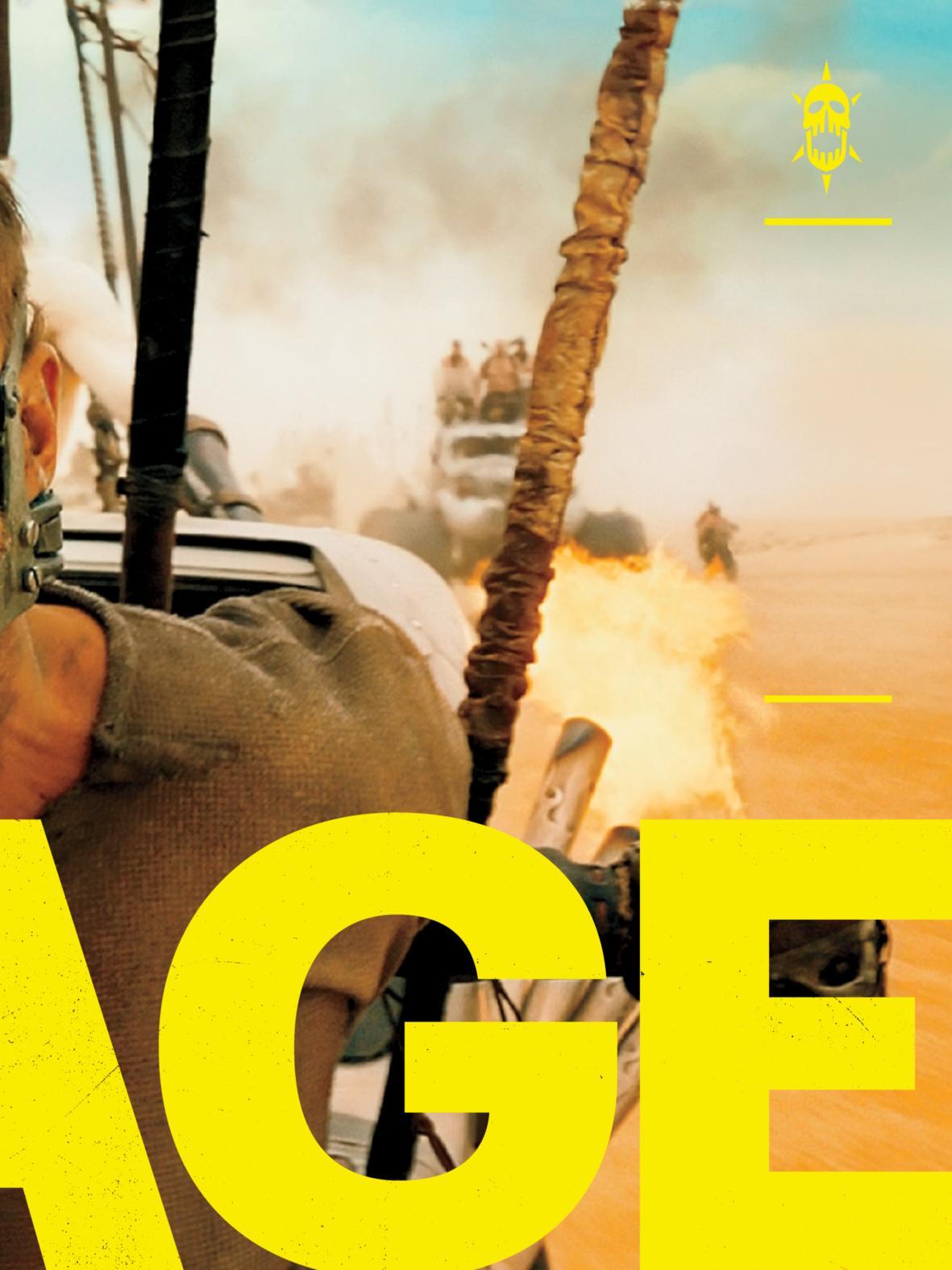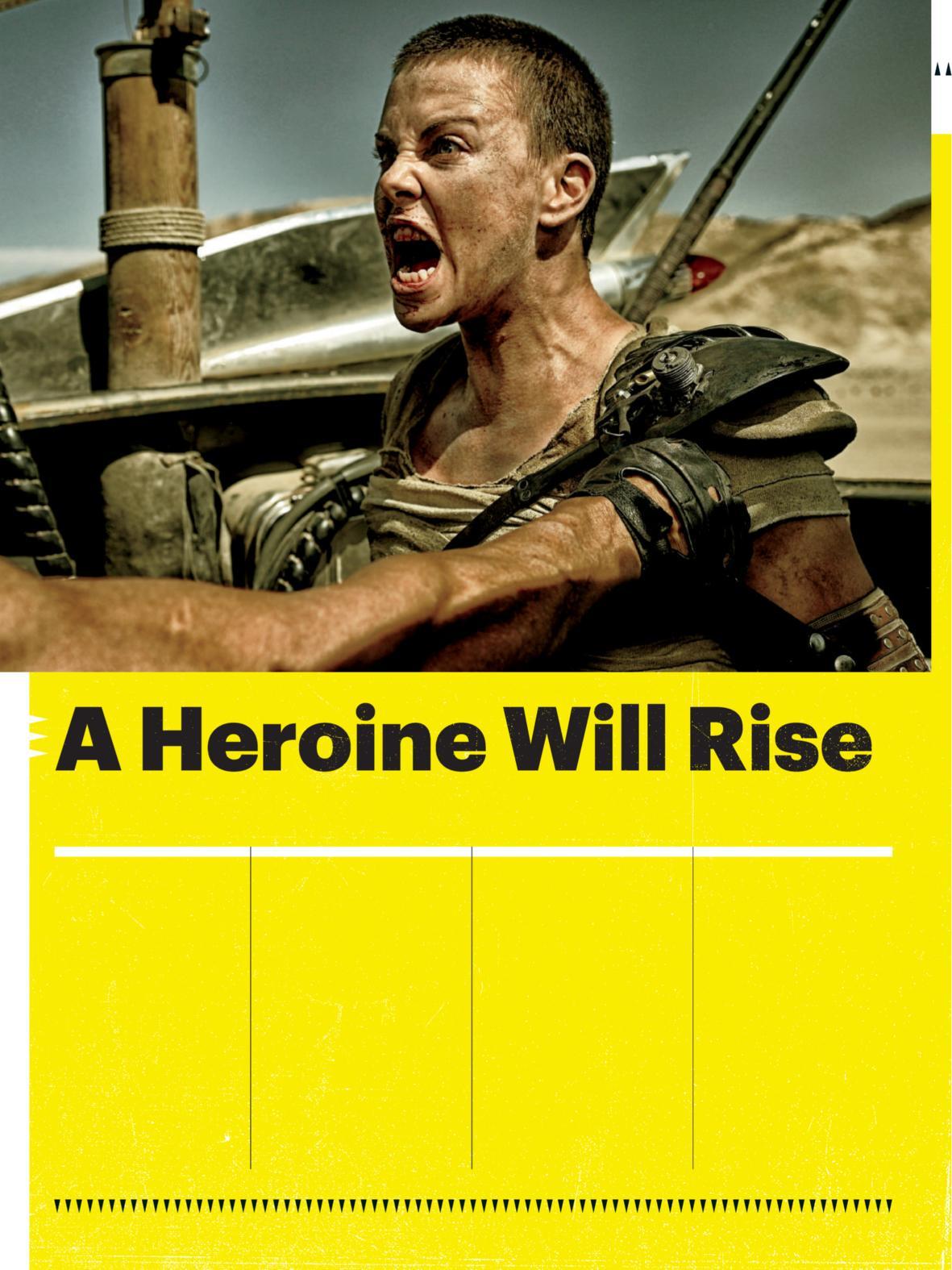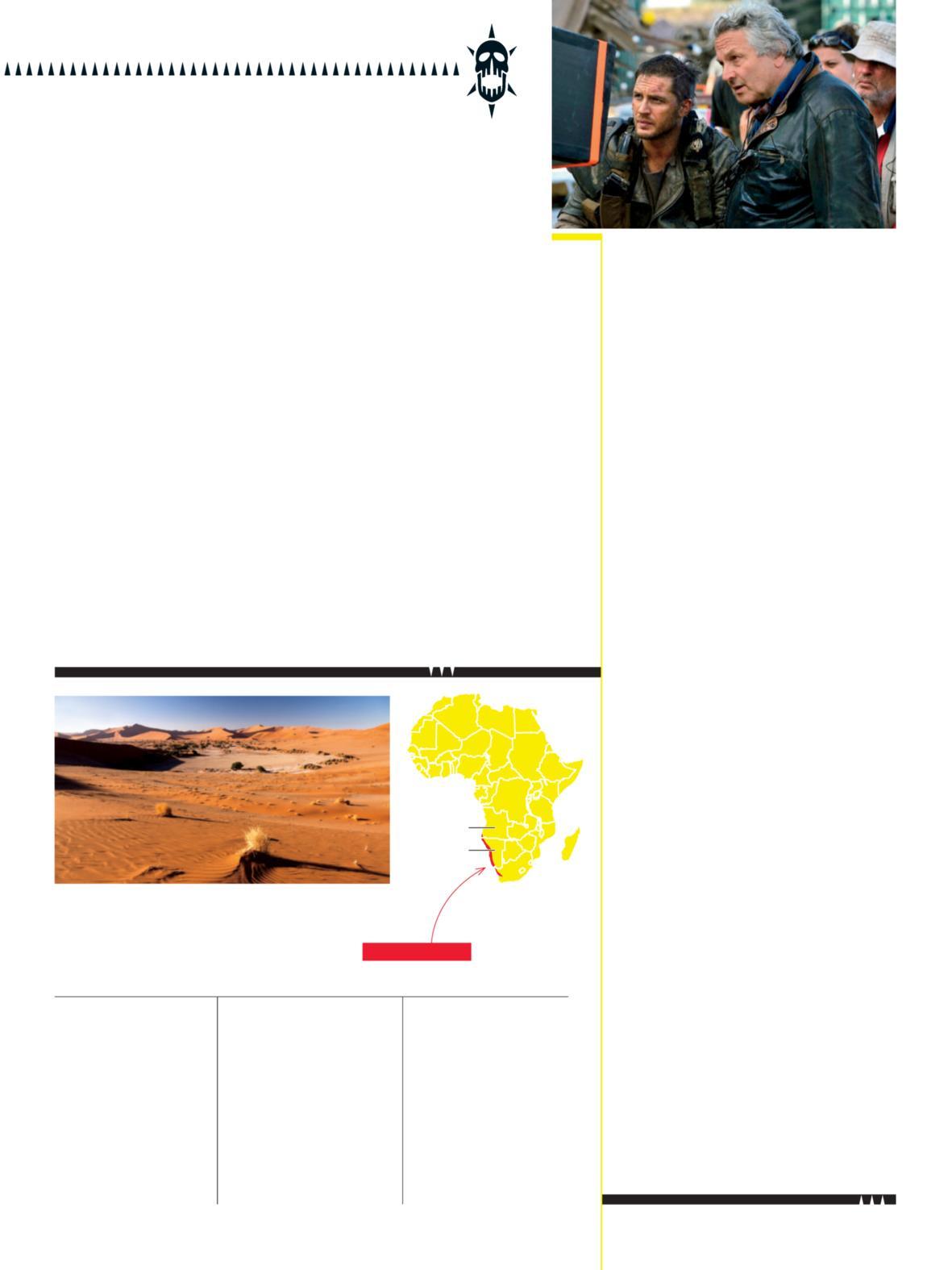
11 minute read
COVER Mad Max: Fury Road
GEORGE MILLER’S MAD MAX: FURY ROAD MAY BE THE MOST DANGEROUS ACTION MOVIE EVER MADE. INSIDE SUMMER’S FULLTHROTTLE RIDE.
BY NICOLE SPERLING
Advertisement

SOME 9,600 MILES FROM THE DESERTS OF NAMIBIA,
George Miller sits in a sound-mixing studio on the Warner Bros. lot, preoccupied with a pair of discordant notes. The 70-year-old director is putting the final touches on his magnum opus, the 12-years-in-the-planning, $150 million Mad Max: Fury Road, a bonkers 120-minute chase where steel, death, and fanaticism meet on the sands of Africa. But Miller can’t think about all that right now. He’s trying to perfect the volume of two stringed instruments—a cello and a bass violin—to articulate the intensity of distrust between his two heroes: Max Rockatansky (Tom Hardy), a broken-down former cop, and Imperator Furiosa (Charlize Theron), a war-rig operator with a partially mechanical arm. ¶ The scene involves Furiosa’s behemoth semi. Max is in the driver’s seat, hungry and weak, with a metal trap clamped over his face. He has tried, and failed, to hijack her truck, and now he needs to decide whether letting her into the cab is the way to go. Oh, and he’s being

chased by an army of malcontents. “You’re sitting on 200 horsepower of nitro-boosted machine,” Furiosa growls, leaning into the cab. “I’d say you’ve got a five-minute head start. You want that thing off your face?”
The notes thrum in the background. “What do you think about reverbing those a bit more?” Miller asks his sound mixer, Chris Jenkins. Jenkins complies, the sound intensifies, and the moment spikes from unnerving to scary. Miller

(Clockwise from top left) Riley Keough and Nicholas Hoult; Hardy and Charlize Theron; Hugh Keays-Byrne likes it. “Getting the tones just right, that’s the big trick,” he says later. “You have to look for moments when you can go quieter; otherwise the movie just becomes one big assault.”
But it is exactly that—one glorious, relentless assault. Fury Road (out May 15)is so overwhelming to the eyes, the ears, the mind, and even the heart that you may never look at action movies in quite the same way again. It’s a movie without sex, with almost no dialogue, set in a toxic wasteland ruled by the warlord Immortan Joe (Hugh Keays-Byrne). The Immortan has enslaved every woman to breed and provide milk to his troops, boys who are dying from their poisoned world and who believe that by fighting for him they will be granted an idyllic afterlife. (All that’s missing from this allegory is the promise of 72 virgins.)
If that sounds a little heavy, we suggest you buckle up. Fury Road may look like the summer’s most high-octane ride, but it also has a lot going on under the hood. This is a movie that challenges our perceptions about women and freedom, heroism and extremism, and perhaps movies themselves. “It’s really intense,” Theron says. “Even for somebody who was there, it’s a lot to take in. I left the theater feeling like I was just hit in the face.”
HEN MEL GIBSON FIRST STEPPED OUT OF
that black Ford Falcon, armored in black leather and rage, in 1979’s Mad Max, he became the newest incarnation of a centuries-old archetype—the lone righteous man yanked into heroism against his will— seen in everything from Greek mythology (Odysseus) to Westerns (the Man With No Name) to Star Wars (Han Solo). In that first film Max is a man seeking revenge for the murder of his wife and son, a motivation that would fuel two ’80s sequels (The Road Warrior and Mad Max Beyond Thunderdome) before the franchise petered out.
So when Miller decided, almost 30 years later, to reimagine this postapocalyptic world for a new millennium, he needed to rethink Max, too, right down to his core. This time Max is a man wounded by his past, with nothing to lose but nothing to live for, either. “[Since Thunderdome] we are much more aware of post-traumatic stress,” says Miller, who has spent the intervening decades making life-affirming films such as Lorenzo’s Oil and Happy Feet. “Our culture has shifted, and even our superhero myths are able to address more damaged characters. You can’t stay still with Max. You have to keep exploring.”
As the film opens, Max has been captured by the Immortan’s goons and hung upside down so they can drain his blood directly into their own arms. Not exactly a hero’s welcome. “It’s an interesting unveiling of someone who is dormant who crawls back into the present,” says Hardy, 37, a British actor who has built a career playing inscrutable men, including the masked villain Bane in The Dark Knight Rises and the mysterious lone driver in the indie Locke. “Rarely do you get a hero who comes in who’s a bit rubbish. He’s world-weary and tired and wants a pair of slippers and a nice warm bath, and he doesn’t have any of that.”
All those elements intrigued Hardy, but he didn’t want to sign on to the film without the blessing of Gibson, the only other man to have played the role. So Hardy asked him to lunch, and brought him a goodwill token: a handmade bracelet fashioned out of military paracord. (In the new film, Hardy’s Max wears one just like it.) “I was a little bit intimidated,” Hardy says. “Who wouldn’t be?” But it worked. Gibson phoned Hardy’s agents after the meeting. “He said, ‘I think you may have possibly found someone madder than I am,’” Hardy says. “That’s a compliment, right?”
The real madness in Fury Road, though, comes not from Max but from Furiosa. To escape the slavery endured by all women, Furiosa has degendered herself into a sort of eunuch warrior. She intends to return to the home she was stolen away from as a child and forge a new world for herself and the five
CHARLIZE THERON’S IMPERATOR FURIOSA IS UNLIKE ANY OTHER FEMALE ACTION HERO IN HISTORY, AND THE OSCARWINNING ACTRESS BATTLED FOR EVERY ANGRY INCH OF HER. BY NICOLE SPERLING

Creating an icon isn’t easy. As he began to design the world of Mad Max: Fury Road, director George Miller and his team experimented with multiple looks for Charlize Theron’s Imperator Furiosa. They scrapped an albino tribal vibe with platinum hair and periwinkle blue war paint. Ditto one with facial scarring. It was Theron herself who unlocked the image of the androgynous warrior— a woman who has escaped the fate of other women by erasing her gender.
“I just said, ‘I have to shave my head,’ ” Theron recalls. Furiosa is a war-rig operator living in a place where all other females have been enslaved as breeding and milking chattel. But Furiosa is barren and therefore of no value to the despot Immortan Joe and his soldiers. She is considered worthless. ”They almost forget she’s a woman, so there is no threat,” she says. “I understood a woman that’s been hiding in a world where she’s been discarded.”
Miller had conceived Furiosa as a narrative counterweight to an apathetic Max (Tom Hardy), a man who may be alive but who has abandoned all hope of ever living. Furiosa, by contrast, is seething at the ruler (and the culture) that rejected her, and is determined to build a new world for herself and her sisters. But her primary motivation is not some earth-mother altruism. It’s vengeance. “I didn’t want Furiosa to be this girl who saves all the young, pretty girls from their horrible state,” says Theron, who had lobbied Miller hard for the role from the moment she heard about it. “I wanted it to be way more personal than that. I wanted it to be a story about her revenge and her hurt and her not feeling good enough.”
It is her rage, not Max’s, that drives Fury Road and sets Furiosa apart from other big-screen alpha women. “Ripley in Alien is probably close, but that’s so different,” Miller says. “All I know is, I cannot think of another female character in cinema who’s like her.” In other words, what looks like a testosteronefueled summer escape is actually a badass feminist action flick. The men do the damage, but the women restore humanity. “What runs loudly for me is the importance that women have in this world of survival,” Theron says. “I was very happy to be a girl with boobies and to be part of that.”
women—the “property” of Immortan Joe—she’s stolen in her rig.
The Immortan’s men take off after her, including Nux (Nicholas Hoult), who’s draining Max’s blood into his arm at the time. (He hits the road with Max, as his IV bag, strapped to the front of his car.) Furiosa is the change agent and the catalyst for everything that happens next. “The thing that drives her is this overwhelming feeling of wanting to take ownership of her life and wanting to go back to a place of safety,” says Theron, 39, who won an Oscar for her lead role in the 2003 drama Monster. “I’ve been doing this for 20 years, and I didn’t think it was going to be an action movie that allowed me to explore a character this raw.”
It would be noteworthy if Miller had simply flipped the gender roles and made Furiosa the alpha to a beta Max. But the director has done something more provocative than that. What elevates Fury Road is that neither Max nor Furiosa is a lone fighter. They are interdependent, and their survival depends on each character’s ability to trust and rely on the other. “I was very attracted to the idea of having a female warrior as Max’s equal,” says Miller. “What would Max do with someone who’s very damaged? To what extent could his humanity be pulled out of these wild events?” Those questions prove to be more revealing than any romance would have been. That Miller answers them without ever taking his foot off the accelerator makes the movie not just remarkable but almost unprecedented. Getting there, though, was as brutal as the story itself.
Hardy and director George Miller on set
THERON, HARDY AND MILLER: JASIN BOLAND (2); NAMIB DESERT: HOBERMAN/UIG VIA GETTY IMAGES Angola

Namibia
Hell on Earth
MAD MAX: FURY ROAD WAS SHOT IN THE VAST NAMIB DESERT, ONE OF THE PLANET’S HOTTEST AND LONELIEST PLACES. BY DEVAN COGGAN
There’s a reason they call it “the land God made in anger.” The Namib, considered the oldest desert in the world, stretches along the southwestern coastline of Africa across three countries—Angola, Namibia, and South Africa—with more than 30,000 square miles of scorched earth. It was here that George Miller decided to shoot Mad Max: Fury Road after rains forced him to scrap plans to shoot in the Australian outback.
The Namib was a minor hot spot for filmmaking a decade ago, serving as the locale for Beyond Borders starring Angelina Jolie and Flight of the Phoenix with Dennis Quaid. It almost never rains there, and temperatures can soar well above 100 degrees amid some of the tallest dunes on earth. A miserable place for sure, but the perfect setting for a dystopian tale. “It didn’t feel like everybody was going to set every day,” Miller says. “It felt like we were going out into the wasteland.”
ALMOST EVERY BREAKNECK SEQUENCE
and car flip, explosion, and person attached to a moving vehicle in Fury Road is real. Miller wanted to avoid CGI as much as possible, and so, over five months of shooting in the Namibian heat, the director and his team constructed elaborate set pieces that often scared the hell out of them. “You see people rolling cars, flying off things, breaking things, breaking legs,” Hardy says. “We had one motorbike rider fly through the air and put his teeth right through the handlebars on the landing. It’s pretty nasty.”
Working without a net, and often without a script, the cast sometimes felt like the whole film might fly off the handlebars too. “There were times when I was like, ‘George! What are we doing?!’” Theron says. “We would show up with no scene numbers—we couldn’t even have a call sheet. And you look around and go, ‘What the f--- is going on?!’” Then, just when it all seemed on the brink of disaster, she says, “things hit and you look at George and go, ‘All right. That was awesome.’”
That’s not to say she’s eager to do it again. Miller and his co-writers have written more installments, and Hardy says he’s up for another round, but Theron, well, she’s not saying no exactly... “There’s no part of me that’s like, ‘No f---ing way will I ever do that [again],’” she says. “But this movie was made, for George, for all the right reasons. Unless that happens again, I wouldn’t trust the process.”
And anyway, Miller’s too busy completing the film to get too wound up about launching a sequel. Still, it’s clear he’s invigorated by what he’s just achieved. “Given that it was such a tough film to make,” he says, starting to laugh, “I’m quite comfortable in saying it’s way better than it has a right to be.” It may, in fact, be his best. ■










